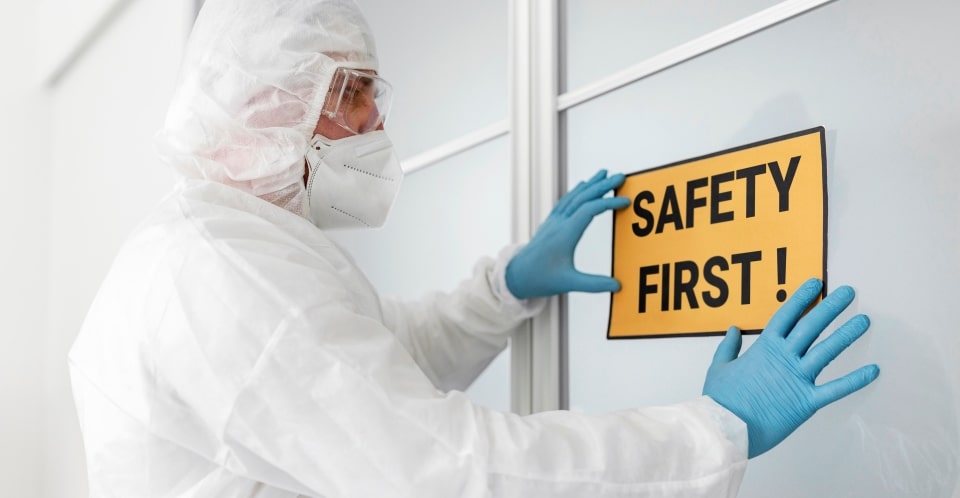Handling hazardous chemicals in the workplace poses significant risks to the health and safety of employees. Proper safety measures, including the use of appropriate safety gear, are paramount to protect workers from the harmful effects of these substances. In this blog post, we will explore essential safety gear for hazardous chemical handling, highlighting the importance of personal protective equipment (PPE) and providing guidance on selecting the right gear to ensure maximum protection.
- Understanding the Risks: Begin by discussing the potential risks associated with handling hazardous chemicals. Explain the various ways these substances can enter the body, such as inhalation, skin contact, or ingestion. Emphasize the importance of recognizing and assessing the specific hazards present in the workplace to determine the necessary safety gear.
- Chemical-Resistant Gloves: Highlight the importance of chemical-resistant gloves in protecting the hands and skin from chemical exposure. Discuss different glove materials, such as nitrile, neoprene, or butyl rubber, and their compatibility with specific chemicals. Provide guidelines for selecting gloves based on the type and concentration of chemicals being handled.
- Protective Clothing: Discuss the significance of wearing protective clothing to minimize skin exposure to hazardous chemicals. Explore options such as chemical-resistant suits, coveralls, or aprons made from appropriate materials. Emphasize the need for full-body coverage and proper fitting to ensure maximum protection.
- Eye and Face Protection: Address the importance of eye and face protection when working with hazardous chemicals. Discuss safety goggles, face shields, and full-face respirators as suitable options. Explain the necessity of selecting eye and face protection that is specifically designed to resist chemical splashes and vapors.
- Respiratory Protection: Explain the importance of respiratory protection for preventing the inhalation of harmful chemical fumes, vapors, or airborne particles. Discuss the various types of respirators available, such as gas masks, air-purifying respirators, or self-contained breathing apparatus (SCBA), and their suitability for different levels of chemical exposure.
- Foot and Leg Protection: Address the need for foot and leg protection in hazardous chemical handling environments. Discuss the importance of chemical-resistant boots or shoe covers to prevent chemical splashes or spills from reaching the feet. Highlight the importance of selecting footwear with appropriate chemical resistance and slip-resistant properties.
- Emergency Showers and Eyewash Stations: Highlight the significance of emergency showers and eyewash stations in areas where hazardous chemicals are handled. Discuss the importance of quick and easy accessibility to these facilities to immediately rinse off chemicals in the event of spills or accidental exposure.
- Training and Education: Emphasize the importance of proper training and education on the correct use of safety gear for hazardous chemical handling. Discuss the need for comprehensive training programs that cover the selection, use, maintenance, and disposal of safety gear. Encourage employers to provide regular refresher courses to ensure employees stay informed and competent in using the required safety gear.
- Regulatory Compliance: Highlight the need to comply with relevant safety regulations and standards when selecting and using safety gear for hazardous chemical handling. Mention regulatory bodies such as the Occupational Safety and Health Administration (OSHA) in the United States or corresponding local authorities. Encourage employers to stay updated on the latest guidelines and regulations to ensure compliance.
- Ongoing Evaluation and Maintenance: Conclude the blog post by stressing the importance of ongoing evaluation and maintenance of safety gear. Encourage employers to regularly assess the effectiveness of the safety gear, conduct inspections, and replace damaged or expired equipment promptly. Reinforce the notion that safety gear is a dynamic aspect of worker protection that requires continuous attention and care.
Conclusion:
When handling hazardous chemicals, providing workers with the appropriate safety gear is vital for their well-being and protection. By understanding the risks associated with chemical handling and investing in high-quality personal protective equipment (PPE), employers can create a safer work environment and minimize the potential health hazards for their employees.

